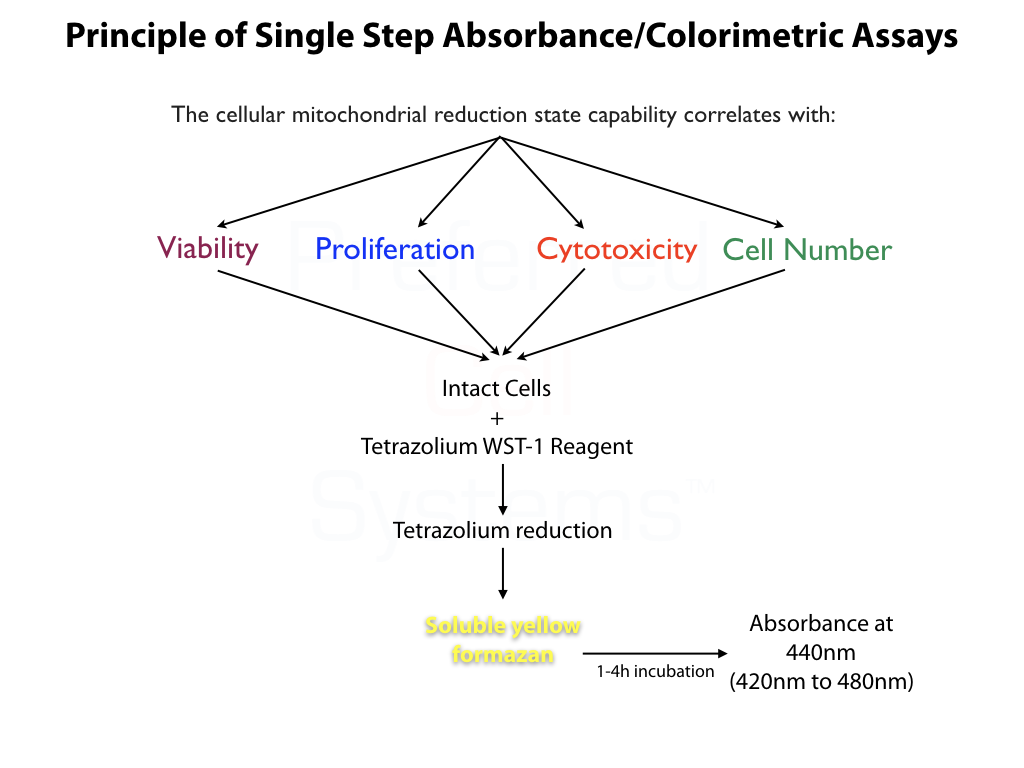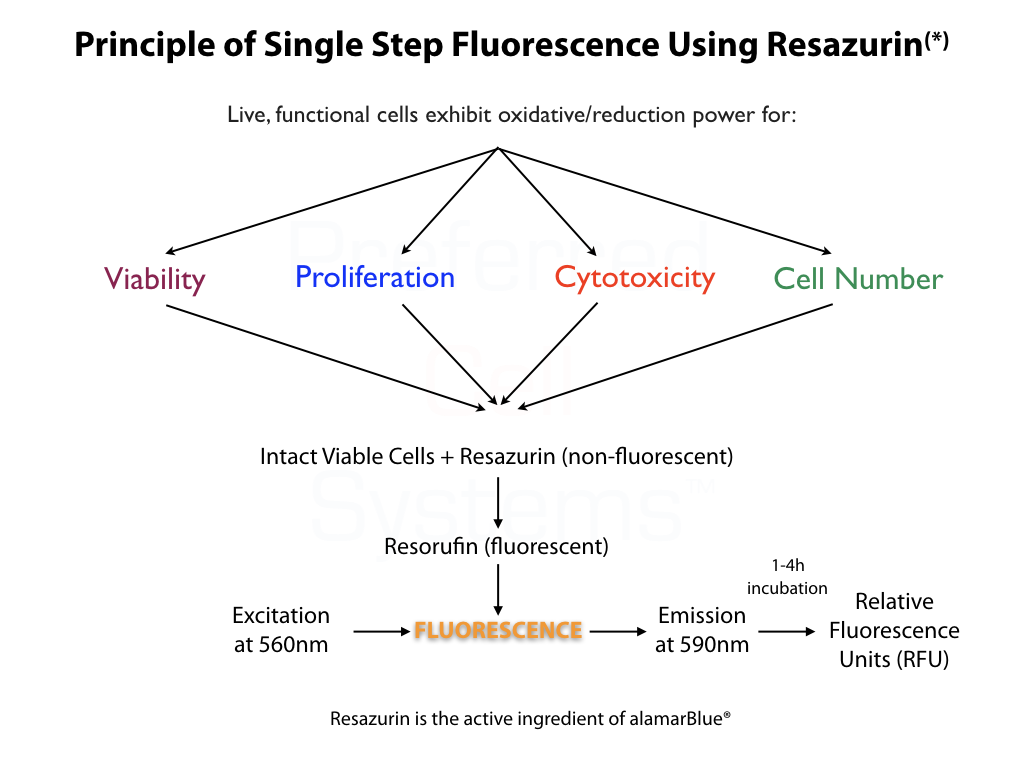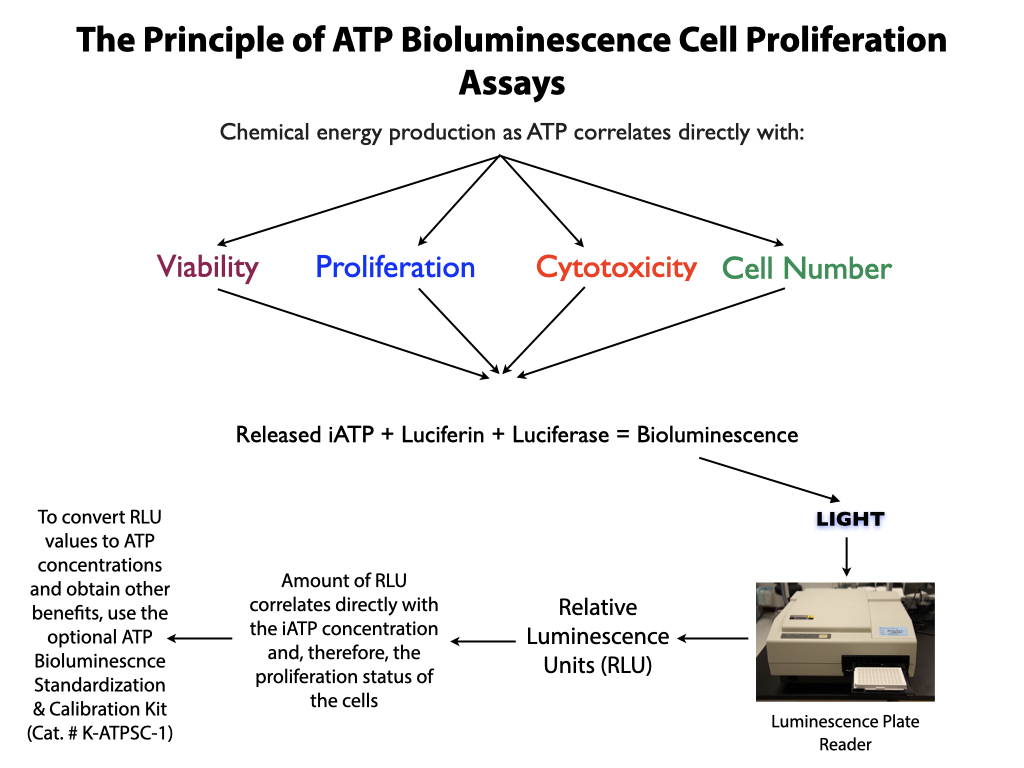
Assay Readouts of Interest
The assay readout, which also be considered the "signal detection system" of the assay, is the method by which the cell response and, therefore, the results, of the assay are measured. The quality of results is dependent upon the assay readout.
Preferred Cell Systems™ offers assays with three different types of readout.
- An absorbance or colorimetric readout is used with a plate reader for 96-well plate assays. These include HemoLIGHT™, ImmunoLIGHT™ assays, MSCLight™, CardioLIGHT™, CellaLIGHT™, EpiLIGHT™, HepatoLIGHT™, NeuroLIGHT™, RenalLIGHT™, SkinLIGHT™ and STEMLight™. Also included in the "LIGHT" assays are those for cellular therapy.
- A fluorescence readout is also used with 96-well plates and a fluorescence or multi-mode plate reader. The "FLUOR" assays include HemoFLUOR™ and MultiCellGro™, ImmunoFLUOR™, MSCFluor™, CardioFLUOR™, CellaFLUOR™, EpiFLUOR™, HepatoFLUOR™, NeuroFLUOR™, RenalFLUOR™, SkinFluor™, STEMFluor™ and some cellular therapy and immunotherapy assays.
- An ATP bioluminescence "GLO" readout is for both 96- and 384-well plate assays and includes the HALO® assays, HemoGLO™, ImmunoGLO™, MSCGlo™, CardioGLO™, CellaGLO™, EpiGLO™, EpiCLONE™, HepatoGLO™, NeuroGLO™, RenalGLO™, SkinGLO™, STEMGlo™, STEMGlo™ IPS, STEMClone™ and some cellular therapy assays. "GLO" assays are also used for in vitro toxicity testing and screening.
It is important that the user understands the pros and cons of each type of assay readout. In addition, the type of assay readout used will depend upon the instrumentation available. Prior to considering each readout in more detail, it is important to ask the the following questions:
- What biological process needs to be measured? Proliferation, differentiation or maturation? Each process requires a different readout.
- What sensitivity and accuracy is required? For example, do I need to compare the response of different cell types, different species or the "quality" of the cells?
- Do I need a quantitative, semi-quantitative or subjective measurement?
- Do I need an instrument-based measurement?
- Do I need a standardized and validated assay?
- Is the cost of the assay an issue?
- Are the results going to be used for internal use only or will they be used for publication or submitted to regulatory agencies?
ABSORBANCE OR COLORIMETRIC ASSAY READOUT

There are several types of absorbance readout. Many involve the biochemical reduction of a tetrazolium compound by the cell's mitochondrial system to produce a colored compound that is measured using an excitation and emission filter. All absorbance/colorimetric "LIGHT" assays from Preferred Cell Systems™ utilize the tetrazolium WST-1 readout from Roche.
Pros
- Used by Preferred Cell Systems™ for measuring cell proliferation, not differentiation or maturation.
- The most cost-effective, instrument-based assay.
- All "LIGHT" assays from Preferred Cell Systems incorporate a WST-1 single-addition, tetrazolium reagent from Roche to produce a yellow formazan that absorbs light at between 410 and 480nm.
- Uses a "live cell" measurement, so that the "LIGHT" assays can be multiplexed with other readouts.
- An absorbance plate reader is one of the cheapest instruments for measuring cell viability and/or proliferation/cytotoxicity.
- Quantitative results.
- Good precision.
- Instrument software allows easy setup and basic statistics to be performed that can be exported to a spreadsheet, e.g. MS Excel, for further analysis.
- An absorbance plate reader can be used for many other absorbance assays, e.g. ELISA.
- Can incorporate controls.
- Can be used in high-throughput mode.
- 96-well plate read in less than 10 minutes.
Cons
- Usually considered the least sensitive of all light-based readouts (see fluorescence and luminescence readouts below).
- Color reaction usually needs 1-4 hours to develop before results can be obtained.
- Difficult to validate because standard reagents are not available.
- May require third-party software for analyzing results.
FLUORESCENCE ASSAY READOUT

The fluorescence readout used in all "FLUOR" assays from Preferred Cell Systems™ incorporates a non-fluorescent Resazurin or alamarBlue® Reagent which reacts with the cells to produce a fluorescent Resorufin product that excites at 560nm and emits at 590nm.
Pros
- Used in assays by Preferred Cell Systems™ to measure cell proliferationcytotoxicity and viability, but not differentiation or matureation.
- All "FLUOR" assays are "live cell" assays, meaning that they can be multiplexed with other assays, e.g. flow cytometry, so that both cell proliferation and differentiation/maturation can be detected and measured.
- Quantitative results.
- Good sensitivity and very good precision.
- Instrument software allows easy setup as well as statistics and other calculations to be performed and the results exported to a spreadsheet, e.g. MS Excel, for further analysis.
- A fluorescence plate reader can be used for many other fluorescence assays.
- Can incoporate controls.
- Can be used in high-throughput mode.
- If available, the instrument can be used for 96- and 384-well plates.
- Results can be read in less than 10 minutes.
- Instruments can incorporate multimode, allowing absorbance and luminescence reading.
Cons
- Reaction needs between 1-3 hours to develop prior to reading results.
- No standardization and, therefore, difficult to validate.
- More expensive than an absorbance assay.
- Instruments can be fairly expensive, but can also measure different types of fluorescence.
- May require third-party software for analyzing results.
BIOLUMINESCENCE ASSAY READOUT

The readout used in all HALO® and "GLO" assays is ATP bioluminescence. Intracellular ATP produced in the mitochondria of all cells is released by lysing the cells with a single reagents that also include luciferin and luciferase. The released intracellular ATP acts as a limiting reagent for the luciferin-luciferase reaction to produce bioluminescence, which is measu,re in a luminescence plate reader.
Pros
- The most sensitive of all non-radioactive signal detection systems and even more sensitive than radioactive markers.
- Ideal for detecting and measuring extremely rare cell types, e.g. primitive stem cells.
- Results can be read within 10 minutes of adding the ATP Enumeration Reagent.
- No filters necessary to read bioluminescence.
- Bioluminescence remains stable for at least 30 minutes.
- All HALO® assays include standards and controls to calibrate and standardize the assay.
- All "GLO" assays have optional standards and controls available.
- Extremely high precision.
- Instruments available for 96-, 384 and 1,536-well plates.
- Ideal for high-throughput applications.
- Depending on the manufacture and instrument, complex statistical analyses can be performed on the results without third-party software.
- All HALO® and "GLO" assays require lysis of the cells. Assays are therefore not amenable to multiplexing without additional replicate wells being setup specifically for other assay readout.
- A dedicated luminescence plate reader with sophisticated software included can cost as much a high quality microscope.
- More expensive than a fluorescence or absorbance assay.